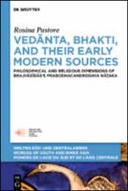Explore

Vedānta, Bhakti, and Their Early Modern Sources
Rosina Pastore
2024
0 Ungluers have
Faved this Work
Login to Fave
This volume considers the Prabodhacandrodaya Nāṭaka (c. 1760 CE), an allegorical drama composed by Brajvāsīdās in Brajbhāṣā. It contributes to the study of vernacular nāṭakas with its first complete English translation. Moreover, the critical analysis shows that the foundational Sanskrit texts for Vedānta and those for Bhakti play a part in the Prabodhacandrodaya Nāṭaka’s philosophical and religious edifice. At the same time, the investigation demonstrates that Brajvāsīdās expresses several philosophical ideas by adaptively reusing the Rāmcaritmānas by Tulsīdās (c. 1574 CE). Brajvāsīdās composes a dohā by combining one line of his invention with a line from the Mānas. This method is employed throughout all the personified metaphysical concepts. That Brajvāsī not only read Bhakti but also Vedānta through the Rāmcaritmānas highlights the philosophical and literary creativity in 18th c. North India. It points to the necessity to rethink the sources of Vedānta philosophies, by including works non-conventional for language and genre, because not in Sanskrit and not śāstras. Such sources may not be original in their contribution per se but are essential to understand how early modern philosophy was done, conceived and transmitted. ; This volume considers the Prabodhacandrodaya Nāṭaka (c. 1760 CE), an allegorical drama composed by Brajvāsīdās in Brajbhāṣā. It contributes to the study of vernacular nāṭakas with its first complete English translation. Moreover, the critical analysis shows that the foundational Sanskrit texts for Vedānta and those for Bhakti play a part in the Prabodhacandrodaya Nāṭaka’s philosophical and religious edifice. At the same time, the investigation demonstrates that Brajvāsīdās expresses several philosophical ideas by adaptively reusing the Rāmcaritmānas by Tulsīdās (c. 1574 CE). Brajvāsīdās composes a dohā by combining one line of his invention with a line from the Mānas. This method is employed throughout all the personified metaphysical concepts. That Brajvāsī not only read Bhakti but also Vedānta through the Rāmcaritmānas highlights the philosophical and literary creativity in 18th c. North India. It points to the necessity to rethink the sources of Vedānta philosophies, by including works non-conventional for language and genre, because not in Sanskrit and not śāstras. Such sources may not be original in their contribution per se but are essential to understand how early modern philosophy was done, conceived and transmitted.
This book is included in DOAB.
Why read this book? Have your say.
You must be logged in to comment.
Rights Information
Are you the author or publisher of this work? If so, you can claim it as yours by registering as an Unglue.it rights holder.Downloads
This work has been downloaded 52 times via unglue.it ebook links.
- 52 - pdf (CC BY-NC-ND) at Unglue.it.
Keywords
- Bhakti
- Early modern
- Humanities
- Interdisciplinary Studies
- Philosophy
- Reference, information & interdisciplinary subjects
- Regional studies
- thema EDItEUR::G Reference, Information and Interdisciplinary subjects::GT Interdisciplinary studies::GTM Regional / International studies
- thema EDItEUR::Q Philosophy and Religion::QD Philosophy
- Vedanta
- vernacular
Links
DOI: 10.1515/9783111063836Editions

